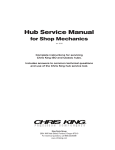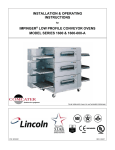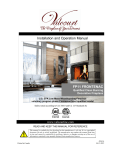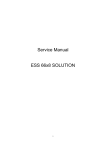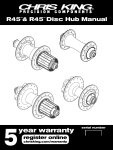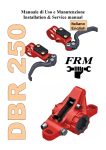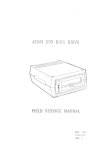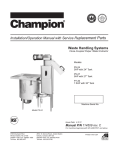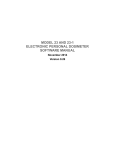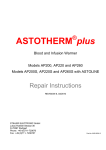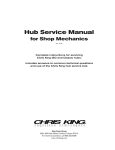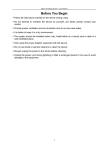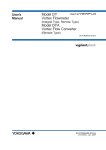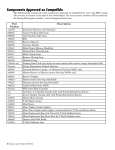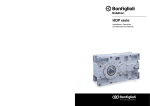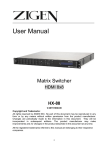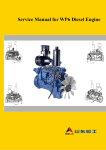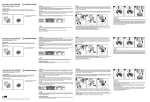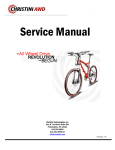Download Hub Service Manual - Amazon Web Services
Transcript
Hub Service Manual for Shop Mechanics Part #17990 rev.11/14 Complete instructions for servicing Chris King ISO and Classic hubs. Includes answers to common technical questions and use of the Chris King hub service tool. King Cycle Group 2801 NW Nela Street; Portland, Oregon 97210 For technical questions, call 800.523.6008 www.chrisking.com HUBSETS This manual is intended for the mechanic who already possesses a familiarity with hubset adjustment techniques and who are interested in the learing how to completely overhaul their Chris King Classic or ISO hubsets. Features • Classic,HighFlange,ISODisc,singlespeed,andtandemhubsavailable • ExclusivepatentedRingDrive™ engagement system offers 72 points of instant and positive engagementandextremlyhightorquecarryingcapacityidealforhardracing,tandems, etc. • Bearingsarefullyserviceableandareavailableineithersteelorceramicoptions • Strongandstiff19.5mmaxles • In-housedesignandmanufacturing-100%madebyChrisKingintheUSA • Unparalleledqualityandreliability • Responsiblylightweight set-up GettinG started and Cautions The following issues that are important to review before servicing and/or trouble shooting your Chris King hub: Adjust the preload on the bearings directly after building the wheel Spoke tension pulling out on the flanges can slightly loosen the preload adjustment on the bearings.Thehub(s)comepre-adjustedfromthefactoryanticipatingbothspoketensionand skewer compression. However, because of variations in wheel-building practices, a minor adjustment should always be performed upon completion of the wheel build. Please see the appropriate “adjustment” section and check the hub before using. Chris King hubs feature adjustable bearing preload Thebearingsshouldbekeptinproperadjustmentforoptimumproductperformance.Donot allow the adjustment to become loose, as this may cause a loss of performance that could lead to damage to the hubs. 2 Rev. 11/14 Use steel quick releases for maximum rigidity Our19.5mmaxleisoneofthestiffestavailable.However,performancewillbemaximizedwith the stiffest possible attachment to the frame or fork. Some Chris King hubs are designed to be usedinconjunctionwithquick-releaseskewers.Itisrecommendedthattheskewerdevelop a minimum of 1100 lb. of clamping force when set. For best performance, use a steel skewer. Titanium skewers are not recommended. Use only the recommended bolts with our bolt-on hubs Never use thread locking or mounting compounds Thread locking compounds are not an acceptably reliable substitution for loose threads or press fitsinhighperformancecomponentry.AllChrisKingcomponentsarepreciselyengineered toexactingtolerancestoeliminatetheneedforthreadlockingcompounds. Use “spidered” cassettes with our aluminum driveshells The aluminum driveshells of the rear hubs are softer than the steel driveshells, and we recommendtheuseof“spidered”-stylecassettes.Avoidusing“individual”-stylecogsetswith the aluminum driveshells. Normal notching from individual cog wear should be knocked down with a file. General cautions When using any Chris King product in conjunction with other manufacturers’ parts, be sure to follow all manufacturers’ instructions and recommendations. Donotattempttomodifyyourhubtoacceptanytypeofbolt-onretentiondeviceoutsideof availableChrisKingaxlesystems. Break-in & Wheel BuildinG Break-in Once your new hub is placed in service, some settling will occur. Check adjustment by clamping wheelintoframeorfork.Ridefor5-10minutes,checkforplayorbinding,andreadjustif necessary.Recheckafterthefirst5-10milesofriding.Checkcoglockringonrearhubs after their first use, and tighten if necessary. Continue monitoring for the first 60 hours of use. Duringthefirst60hoursofuse,expectsomebreak-indrag.Thisisnormalasthesealsbreak in,andwillsoondiminish.Ifthiscauseschainsagintherearwhileback-pedaling,increase thep-tension(cagetension)ontherearderailleur. Thebearinggreaseisintentionallyoverpackedandexcessgreasemayseepatthebearing sealsduringthebreak-inperiod. Rev. 11/14 3 Frame preparation AllChrisKinghubsaredesignedtoworkwithspecificforkanddropoutspacing.Donot attempt to modify your hub to work with a spacing other than for which it was intended. AftermarketaxlesandconversionkitsareavailablethroughyournearestChrisKingdealeror online thorugh our webstore at www.chrisking.com. Checkforkandframe dropoutstoensuretheyareparalleltoeachother.Useanapproriate tool such as those made by Park™ or Campagnolo™.Unparalleldropoutsmaybeunsafeand/ or compromise the performance of your Chris King hub. Wheel building - hubs ChrisKinghubsaredesignedtoworkwith14or15gaugespokes.Discbrakewheelsmustbe lacedusingatleasta2-crosslacingpattern.Asthetorquegeneratedbydrivingthecassette requiresacrossedspokes,sodoestheadditionaltorqueonthenon-drivesideflangegenerated by the braking action. Radial lacing your ISO and Classic hub is considered outside of the intended use and will void your warranty. King Cycle Group will not be responsible for damaged or distroyed hubs, any consequential damages, or any resulting labor costs due to radial lacing your ISO or Classic hub. Because of the additional torque caused by the braking action on the front ISO hub we recommend that the hub be laced using a specific crossed lacing pattern. The front ISO shouldbelacedatleast2-crosswiththerotor(left)sidepullingspokes(brakingdirection) headsout/elbowsin.Thefinalcrossofthepullingspokeneedstobeontheoutside.As braking force is applied, increased pulling spoke tension will pull the crossed spokes towards the center of the hub and away from the caliper. Please use best wheel building practice or seeanexperiencedwheelbuilder. ISOLefty®LDandISOLefty®SuperMaxwheelbuildswillrequiretheuseofatruingstand Lefty® hub adapter tool such as Park’s® TS-TA or Cannondale’s® Lefty® wheel-truing dummyaxle. See Table on pages 40 and 41 for build specs. Installation and removal of the brake rotor adaptor Mountthebrakerotoraccordingtomanufacturer’sinstructions. Adapter installation (See figure 6) 1. Beforeinstallation,thoroughlyclean both the brake rotor adaptor and the splinesonthehubshell.Anydebris on the splines may not allow the rotor to run true, inhibiting the performance of the brake. Figure6-installrotoradaptor 4 Rev. 11/14 2. Place the adaptor onto the splines. When snug, the adaptor should leave an even gap approximatelythewidthofapieceofpaperbetweenthehubandtheadaptor. 3. Insert the three bolts provided. In an alternating pattern, hand tighten adaptor bolts to pull adaptor down evenly. 4. Finishtorqueto28in.-lbor3.16Nm.Donotovertighten. Adaptor removal 1. Removethediscbrakerotorifitcoversthethreemountingbolts. 2. Removethethreeadaptorfixingbolts. 3. To remove the rotor adaptor from the tapered splines, pry between the adaptor and the hub usingtwoopposingplastictirelevers.(itshouldpopoffeasily).Donotusemetalobjects, such as screw drivers, to release the adaptor. Wheel building - BMX Cautions ChrisKingBMXhubsaresuppliedwith3/8”-16x1”socketcapaxlebolts.Replacementscan bepurchasedatmosthighqualityhardwarestores.Useaboltofgrade8orequivalent.Under nocircumstance,shouldaquickreleaseskewerbesubstitutedfortheaxlebolts. DonotusecogsotherthanBMXcogs.Thedriveshelloftherearhubhasauniquesymmetrical spline,andincompatiblewithsomeShimano,andotheraftermarketcogs.Useofothercogs may cause chain slippage, or derailment, which could lead to bodily injury. Installation and removal of the Cog ChriskingBMXhubsuseacassettestylecogmountingsystem.Specialsplinesandlock ringshavebeendesignedtoacceptpremiumqualitysteelcogs.Cogsareavailableinsizes from12tto20t.Usingstandardcassettetoolsyoucaneasilyremoveandchangeyourcogs. Cog installation 1. Selectdesiredtooth-countCog. 2. Slide cog onto driveshell spline. Cogs are symmetrical, and can be installed with either side out. 3. Thread lock ring onto driveshell over cog. 4. InsertShimanoHG™-styletoolintolockring,andtightento20ft.-lbor27.12Nm. Cog removal 1. 2. 3. 4. Usingachainwhip,holdcogstationaryfromcounterclockwiserotation. InsertShimanoHG™-stylecassettetoolintolockring. Loosen and remove lock ring by rotating it until it is free from driveshell. Slide cog off of spline. huB Rev. 11/14 serviCe 5 MaintenanCe sChedule ChrisKingHubsaredesignedtoprovidelonglifeandhighperformance.Beyondanoccasional adjustment, the only maintenance necessary is cleaning, lubricating the RingDrive™ (see “Maintenance of the RingDrive™ & driveshell”,page6),andre-lubricatingthebearings(see “Bearingservice”,page9).Ridingconditionswilldeterminehowoftentomaintainyourhubs. Asabeginningguideline,yourhubsshouldbemaintainedevery6-12monthsinnormaland dry conditions and every 3 months in wet or muddy conditions. The bearings in your new Chris King hubs are of the highest quality available. However, all bearings will settle and eventually wear with use. Since looseness or “play” in the bearing assembly can develop as a result of wear, Chris King hubs have been designed with an adjustable bearing preload mechanism and any normal play can be eliminated (see the appropriate“...Adjustment”section). RingDrive™ maintenance NormalpreventativemaintenanceoftheRingDrive™ is simple and can be performed using basictools.(See“MaintenanceofRingDrive™ & driveshell”, page 6.) In many cases, a minor cleaning and reapplication of lubricant is all that may be necessary. Judging when to perform thisbasicmaintenanceisdeterminedbyridingstyleandconditions.Asabeginningguideline, yourhubsshouldbemaintainedevery6-12monthsinnormalanddryconditionsandevery3 months in wet or muddy conditions. Lubrication Normal conditions Innormalridingconditions(0°-43°C),ourRingDrive™ lube is recommended for the bearings andtheRingDrive™. Do not substitute other brands of lube, as they may be too sticky for the helix of the RingDrive™ inhibiting proper engagement. Cold conditions Toensureproperengagementinsub-freezingconditions,firstbesurethatthereisnowateror moisture inside the hubshell. The hub may require an overhaul to ensure that the hub interior iscompletelywater-free.ThenmixthegreaseintheRingDrive™ area, especially on the helical splinesofthedriveshell,with5-10dropsofPTFE(e.g.TriFlow™).Ifyouexpecttoberiding in temperatures that are consistently at or below freezing replace all internal lube with a quality 10wsyntheticoil.Donotoverfill.Wereccomendusingasiliconaloil(Pedros®SynLubeor Mobil1®) Wet conditions Riding in wet conditions necessitates more frequent service. Often this is as simple as removingtheaxleanddriveshellfromthehub,removinganymoisturefrominsidethehubshell, and applying more grease to the needle bearing. This should not replace periodic complete disassemblyandmaintenance,especiallyinextremeorprolongedwetconditions. 6 Rev. 11/14 Note: Since it is nearly impossible to seal a hub from water and still have it spin freely, we have designedourhubstobeabletooperatenormallywithsome waterintrusion.Althoughthe bearings are stainless steel and will resist water induced corrosion, the lubricant will eventually deteriorate, leading to premature bearing wear and possible failure. High-pressure spray washing, transporting or riding the bicycle in the rain, or submersion in water while riding can allleadtolubricantcontaminationbywater.Beawareofthesesituationsandservicemore frequently when they occur. In a pinch... IfChrisKingRingDrive™ lube in not available, a quality 10w synthetic oil may be substituted. Do not substitute other brands of grease, as they may be too sticky for the helix of the RingDrive™.RunningthehubonoilwillcausetheRingDrive™ to be more audible, yet functionally no different. If you have any additional questions, please call our Technical Services Department at 800.523.6008. BasiC serviCe Front hubs Disassembly of the front two piece axle hub (See figure 7) Figure7-typicalfrontquickreleasehub 1. Insert 5 mm hex wrenches into both ends of axle assembly.*Pro Tip: Use a bench vice to hold one of the 5mm hex wrenches. 2. Holdlefthandstationaryandturnrighthandcounterclockwise1/4turnuntilassemblyis loose. 3. Loosenandunscrewadjustingconeandaxleenduntiltheyarefreefrommainaxle. 4. Slideoutmainaxle. 5. Bothhubshellbearingassembliescannowbeaccessed. Furtherdisassemblyrequiresspecializedtools.Referto“CompleteAssembly”. Disassembly of the front one piece axle hub (See figure 8) 1. Insert a 2.5mm hex wrench into the adjusting clamp pinch bolt, and loosen. 2. With adjusting cone facing towards Figure8-typicalfrontbolt-onhub you, hold opposite end of axle stationary, and rotate cone in a counterclockwisedirection.After onecompleterevolutiontheadjustingconeshouldbefreefromtheaxle. Rev. 11/14 7 3. Slideoutaxle. 4. Bothhubshellbearingassembliescannowbeaccessed Furtherdisassemblyrequiresspecializedtools.Referto“CompleteAssembly”. Service of the bearings We offer our bearings with either quality steel or ceramic balls, so short term water intrusion should not lead to any substantial damage. Judging when to service the bearings is completely dependent on the riding style and conditions. 1. Chris King sealed bearings have removable snap rings that hold the rubber seals in place. (See figure 9.) 2. Carefully, using a small screwdriver, pick, or penknife, remove the snap ring by inserting tool into split of snap ring. Gently work one end of the snap ring toward bearing center until it is out of its groove. Follow the ring around with the tool until the snap ring is completely dislodged. 3. Lift and remove exposed rubber seal to access the Figure9-seal&snapring interior of the bearing. 4. Thoroughly flush the bearing with a light spray lubricant (e.g.WD-40™)andblowdry.Avoidusingcuasticcleanersandcitrusbaseddetergents. 5. Wipedirtandothercontaminantsfromthesealsandsnaprings.Avoidcleaningtheseals with solvent, which could cause deterioration. Note:somesolvents,syntheticlubricants,andgreaseswithhigh-pressureadditivesmayattack anddamagesealsandothernonmetallicmaterials.Minimizeexposuretothesesubstances and thoroughly dry hub after cleaning. 6. LayabeadofourRingDrive™ grease, filling the gap between the inner and outer races 1/3 for steel balls or 1/4 for ceramic around the large bearing and 3/4 for steel or 1/3 for ceramic around the small bearing. Then rotate the inner race to work grease throughout the ball area. 7. Replacerubbersealbetweeninnerandouterbearingrace. 8. Insert one edge of snap ring into groove of outer bearing race. Press along entire groove until snap ring is fully seated; a small gap should be visible between both ends of the snap ring. 9. Turn inner race of bearing by hand to test for binding. If bearings do not run smooth, repeat steps1-9.Bindingisoftenaresultofimproperlyseatedsealsand/orsnaprings. Usedsnapringsandsealscanbereinstalledunlesswarped,punctured,orotherwisedamaged. If damaged, replacement seals and snap rings are available from your local bike shop or directly fromChrisKingprecisioncomponentsatwww.chrisking.comor800-533-6008. Reassembly of the front quick-release hub 1. Lightlyoilmainaxleo-ringswithlightweight,lowviscosityoil,withPTFE(e.g.TriFlow™). 2. Insertmainaxleintohubshell. 3. Threadadjustingconealongaxleenduntilasmallgapatthebeginningofthethreadsshows. 8 Rev. 11/14 4. 5. 6. 7. Grease the adjusting cone threads with waterproof grease (See figure 10 on the following page.) Threadaxleendandadjustingconeontotheprotruding threadsofmainaxle. Lightlysnugaxleendandadjustingconeuptobearing. Threadaxleendintoadjustingconeuntilitstops. Proceedto“Adjustmentofthefronttwopieceaxlehub” (below). Reassembly of the front bolt-on hub 1. Insertmainaxleintohubshell. 2. Thread adjusting clamp onto the protruding threads of Figure10-adjustingcone axle. 3. Snug adjusting cone up to bearing. 4. Proceedto“Adjustmentof thefrontbolt-onhub”(below). Adjustment of the front two piece axle hub 1. Insert5mmhexwrenchesintobothendsofaxleassembly. 2. Holdlefthandstationaryandturnrighthandcounterclockwise1/4turnuntilassemblyis loose.*Pro Tip: Use a bench vice to hold one of the 5mm hex wrenches. 3. Holdhexwrenchesstationaryandadjustbearingpreloadwithadjustingcone. 4. Advanceadjustingconeuntilitjustcontactsbearing,thenbackoffapproximately1/16turn (thisallowsforaxlecompressionwhileunderskewerclamppressure). 5. Oncepreloadisset,tightenaxleassemblyto110in.-lb.or12.43Nm 6. Doublecheckadjustmentbyclampingwheelintoforkwithquick-release.Checkforplay or binding, and readjust if needed. Adjustment of the front one piece axle hub 1. Front one piece axle hubs feature adjusting clamps which minimize over tightening or over preloading of the bearings. Normal adjustment is accomplished by finger tightening adjustingringontoaxleuntilitstopsagainstbearing.Withadjustingclampfacingtowards you,holdoppositeendofaxlestationary,androtateclampinacounterclockwisedirection tounscrewitfromtheaxle.Ifadjustingclampisdifficulttoposition,inserta2.5mmhex keyinto“helperhole”onadjustingclampadjacentto2.5mmhexbolt.Usethehexkeyas a lever to preload adjusting clamp 2. Onceadjustingclampisinposition,tightenadjustingringpinchboltto10in.-lb.or1.13Nm. 3. Doublecheckadjustmentbyboltingwheelintofork.Checkforplayorbinding,andreadjust ifneeded.Adjustmentmaybeaccomplishedwhileboltedintofork. Rear hubs Disassembly of the rear two piece axle hub The following instructions assume that the driveshell is facing to the right: 1. Removecogusingachainwhip,andstandardShimanoHG-stylefreewheeltool. 2. Insert5mmhexwrenchesintobothendsofaxleassembly.(Seefigure11onthefollowing page.) Rev. 11/14 9 3. Hold left hand stationary and turn right hand counterclockwise 1/4 turn until assembly is loose. 4. L o o s e n a n d u n s c r e w adjusting cone and axle end until they are free from themainaxle. 5. Removemainaxlebypulling on drive side end of main axle. 6. Hold hub or wheel in one Figure11-disassemblemainaxle hand and pull driveshell out with the other. 7. Bothhubshellanddriveshellbearingassembliescannowbeaccessed. Furtherdisassemblyrequiresspecializedtools.Referto“CompleteAssembly”. Disassembly of the rear one piece axle hub The following instructions assume that the driveshell is facing to the right: 1. Removecogusingachainwhip,andstandardShimanoHG-stylefreewheeltool. 2. Inserta2.5mmhexwrenchintoadjustingclamppinchbolt,andloosen. 3. Withadjustingclampfacingtowardsyou,holdoppositeendofaxlestationary,androtate coneinacounterclockwisedirection.Afteronecompleterevolutiontheadjustingcone shouldbefreefromtheaxle.Ifadjustingclampisdifficulttoposition,inserta2.5mmhex keyinto“helperhole”onadjustingclampadjacentto2.5mmhexbolt.Usethehexkeyas a lever to unscrew adjusting clamp 4. Slideoutaxle. 5 hold hub or wheel in one hand and pull driveshell with other. 6. Bothhubshellanddriveshellbearingassembliescannowbeaccessed. Furtherdisassemblyrequiresspecializedtools.Refer to“CompleteAssembly”. Service of the bearings We offer our bearings with either quality steel or ceramic balls, so short term water intrusion should not lead to any substantial damage. Judging when to service the bearings is completely dependent on the riding style and conditions. 1. Chris King sealed bearings have removable snap rings that hold the rubber seals in place. 2. Carefully, using a small screwdriver, pick, or penknife, remove the snap ring by inserting tool into split of snap ring. Gently work one end of 10 Figure12-removesnapring Rev. 11/14 the snap ring toward bearing center until it is out of its groove. Follow the ring around with the tool until the snap ring is completely dislodged. (see figure 12.) 3. Liftandremoveexposedrubbersealtoaccesstheinteriorofthebearing. 4. Thoroughlyflushthebearingwithalightspraylubricant(e.g.WD-40™) and blow dry with an air compressor. 5. Wipedirtandothercontaminantsfromthesealsandsnaprings.Avoidcleaningtheseals with solvent, which could cause deterioration. NOTE:Somesolvents,syntheticlubricants,andgreaseswithhigh-pressureadditivesmayattack anddamagesealsandothernonmetallicmaterials.Minimizeexposuretothesesubstances andthoroughlydryhubaftercleaning.Avoidtheuseofcuasticandacidicdegreaserslike citrus cleaners. 6. LayabeadofourRingDrive™ grease, filling the gap between the inner and outer races 1/3 for steel balls or 1/4 for ceramic around the large bearing and 3/4 for steel or 1/3 for ceramic around the small bearing. Then rotate the inner race to work grease throughout the ball area. 7. Replacerubbersealbetweeninnerandouterbearingrace.* When installing old seal be sure to install seal in its original orientation. 8. Insert one edge of snap ring into groove of outer bearing race. Press along entire groove until snap ring is fully seated; a small gap should be visible between both ends of the snap ring. 9. Turn inner race of bearing by hand to test for binding. If bearings do not run smooth, repeat steps1-9.Bindingisoftenaresultofimproperlyseatedsealsand/orsnaprings. *Used snap rings and seals can be reinstalled unless warped, punctured, or otherwise damaged. If damaged, replacement seals and snap rings are available from your local bike shop or directly from Chris King precision components. Maintenance of RingDrive™ & driveshell Inspection Havingremovedtheaxleanddriveshell(asinstructedabove),theRingDrive™ is accessible through the large side of the hub shell. Visually inspect the hub’s interior. Under normal conditionsthegreaseshouldlookmoistandmayhavedarkenedslightly.Amodestfilmshould coat the moving parts. Aswiththerestofthehub,theRingDrive™ is designed to operate with some water contamination. Water intrusion can usually be remedied with basic maintenance. However,ifforeigndebrisisdetectableinthegreaseand/orthegreaselookshardordry,then acompleteremovalandservicingoftheRingDrive™ is necessary. Basic maintenance 1. Takeaclean,lintfreeragandwipeanyspentlubricantfrominsidethehubshell.Becareful not to drag any dirt or debris from outside the hub into the interior area. Rev. 11/14 11 2. Once the interior is clean in appearance, locate the helical splines of the drive ring about an inch inside the large bearing. 3. Usingasofttoothbrush,pullthebristlesacrossthehelixinanoutwarddirection.Work your way all the way around the inner circumference to remove any small particles that may be in the spline grooves. 4. Oncecompleted,wipetheareadirectlyinfrontofthehelixtoremoveanydebris.This methodshouldbeusedtocleanthehelixonthedriveshellaswell.(Ifcompressedairis available,blowacrossthehelixesinlinewiththesplinegroovestoremoveanydebris.) Withtheinteriorwipeddownandthehelixesbrushedclean,afreshapplicationoflubricant shouldbe applied.TheRingDrive™ is designed to work with our specially formulated low shearRingDrive™ grease. Do not substitute other brands of grease, as they may be too sticky for the helix of the RingDrive™. 5. Lubricate by reopening a gap between the driverings,andlayingabeadofRingDrive™ grease on the teeth between them (see figure 13). 6. Let the rings spring back together . 7. Applyafewdropsoflightweight,lowviscosity oil,withPTFE(e.g.TriFlow™) onto both the helical splines of the movable drive ring and the driveshell (see figure 14). 8. Before reinserting the driveshell into RingDrive™ area of the hub, the helical splines must be clean of any debris. 9. Reinsert the driveshell and complete the assembly as per the instructions below. RingDrive™ service Figure13-lubeRingDrive™ teeth In addition to the basic maintenance of the RingDrive™, a complete removal and servicing may benecessary.CompleteservicerequiresourHub Service Tool Kit and, as a basic guideline, should be performed at least once a season. Check with your local Chris King dealer for complete service or you may purchase the tool kit at your dealer or directly from Chris King Precision Components. In a pinch... IfyouneedtodoaRingDrive™ service and don’t have theHubServiceToolKitorcan’tmakeittoadealer, this method may be used for temporary results: 1. Remove the axle and driveshell to access the interiorRingDrive™ area. 12 Figure14-lubehelicalsplines Rev. 11/14 2. Pushthedriveringwithhelicalsplinesinwardtoopenagap,exposingthedriveteethand flushtheinteriorwithalightsolvent-basedspraylubricant(e.g.,WD-40™) until the area appearsclean.Blowoffanyremainingsolventuntilcompletelydry. 3. If contamination is still apparent, repeat flushing and blow completely dry. A complete service of both hub shell bearings should be performed at the same time. 4. Finish by performing the basic maintenance as instructed above. 5. Afterassembly,carefullyhandtesthubforsmoothoperationofthebearingsandconsistent, positiveengagementoftheRingDrive™. If performance is not improved to original quality, acompleteRingDrive™ removal service must be performed. Reinstallation of the driveshell assembly 1. Check the helical splines of the driveshell for any particles or debris before proceeding; the driveshell must be clean before installing! 2. Applyseveraldropsoflightweight,lowviscosityoil,withPTFE(e.g.TriFlow ™) on the helicalspline,O-ring,andtapereddiameterdirectlyadjacenttheO-ring. 3. Insertdriveshellintohubshell,slowly.AsthedriveshellenterstheRingDrive™ area, it will wanttomeshthehelicalsplinesofthedrivering.Asitbeginstomesh,aslightclockwise turning motion of the driveshell will help pull it into the hub shell. Continue twisting as the driveshellpullsitselfintothehubshell.Atthebottomofitsinwardmovement,anaudible “click” or “pop” sound indicates that it has found home and is fully seated. (The “click” or “pop” is the spring retainer popping onto the driveshell and the driveshell hitting the bearing, indicating the driveshell is fully inserted.) 4. Insertafingerfromthenon-drivesidetounsureproperseating. 5. Test engagement by spinning driveshell in both directions. If it does not engage, remove driveshell,checkcleanlinessandre-insert.Re-test. 6. Thehubisnowreadytohavetheaxleinstalled. Reassembly of the rear two piece axle hub The following instructions assume that the driveshell is facing to the right: 1. Lube o-ring and axle sleeve with lightweight, low viscosity oil, with PTFE(e.g.TriFlow™) 2. Insert main axle through drive shell and completely into hub. Axle should protrude slightly through the non drive side bearing. Figure15-mainaxle Figure16-adjustingcone (See figure 15.) 3. Grease the adjusting cone threads with waterproof grease 4. Threadadjustingconealongaxleenduntilasmallgapatthebeginningofthethreads Rev. 11/14 13 shows. (See figure 16.) 5. Threadaxleendandadjustingconeontotheprotrudingthreadsofmainaxle. 6. Lightlysnugaxleendandadjustingconeuptobearing. 7. Threadaxleendintoadjustingconeuntilitstops. 8. Proceedto“Adjustmentoftherearquick-releasehub”below. NOTE: To improve performance, the axles have been precisely matched with the needle bearingsinthedriveshell.Besuretocombineonlylikenumberedparts,(e.g.,#4axlewith #4 needle bearing race). Reassembly of the rear one piece axle hub The following instructions assume that the driveshell is facing to the right: 1.Lightlyoilallo-ringsandbearingcontactsurfaceswithlightweight,lowviscosityoil,with PTFE(e.g.TriFlow™). 2. Insert driveshell into the hub shell; turn in a clockwise motion while letting it pull itself in . Adistinctiveclicksoundwillindicatethatthedriveshellisfirmlyseated. 3. Insertmainaxle,smallendfirstintodriveshell.Continueuntilaxleisthroughthehuband large end is firmly seated in driveshell. 4. Threadadjustingclampontotheprotrudingthreadsofaxle. 5. Snug adjusting clamp up to bearing. 6. Proceedto“Adjustmentoftherearonepiecehub”(below). Adjustment of the rear two piece axle hub The following instructions assume that the drive shell is facing to the right: 1. Insert5mmhexwrenchesintobothendsoftheaxleassembly.*Pro Tip: Use a bench vice to hold one of the 5mm hex wrenches. 2. Holdleftsidestationaryandturnrighthandcounterclockwise1/4turnuntiltheassembly is loose. 3. Holdhexwrenchesstationaryandadjustbearingpreloadwiththeadjustingthehubcone adjusting tool. 4. Advanceadjustingconeuntilitcontactsbearing.Therearhubtakesaslightlyhigheramount of preload than “no play”, since some settling may occur while riding. 5. Oncepreloadisset,tightenaxleassemblytogetherto110in.-lb.or12.43Nm. 6. Checkadjustmentbyclampingwheelintoframewithquick-release.Ridefor5-10minutes, checkforplayorbinding,andreadjustasnecessary.Doublecheckadjustmentafterthe first5-10milesofriding. NOTE: Correct adjustment of the rear hub is necessary for proper engagement of the RingDrive™.Ifthehubisrunloose,theRingDrive™ may not engage properly and could lead to permanent damage to the internal parts or hubshell. Adjustment of the rear one piece hub 1. Rearonepiecehubsfeaturespecialadjustingclampswhichminimizeovertighteningor over preloading of the bearings. Normal adjustment is accomplished by finger tightening 14 Rev. 11/14 adjustingringontoaxleuntilitstopsagainstbearing. 2. Once adjusting clamp is in position, tighten adjusting clamp pinch bolt to 10in.-lb. or 1.13Nm. 3. Double check adjustment by bolting wheel into frame. Check for play or binding, and readjustifneeded.Adjustmentmaybeaccomplishedwhileboltedintoframe. CoMplete serviCe Introduction to the tool The hub tool is designed to accommodate complete disassembly and reassembly of the following Chris King hubs. • • • • • ClassicandClassicHighFlange-frontandrear UniversalDisc-frontandrear;allstyles ISODisc-frontandrear;allstyles BMX-frontandrear SingleSpeedandSingleSpeedISO- frontandrear. The tool is made up of the following parts 1. T-handle.Thisisthemainpartofthepressingdevice.Itisalongshaftwiththreadsonone end, and a bulbous end with a handlebar through it. It has a steel strike plate in the top of the bulbous end that may be struck with a mallet or ball peen hammer. 2. Extensionshaft.Onceagainathreadedshaftbutmuchshorter.Withaknurledsectionon oneendandsmallthreadsontheother,itscrewsintotheendofthet-handle. 3. Cone washer. This part is a steel washer with one side shaped like a cone. It goes on the smallendoftheextensionshaftbeforeitisscrewedintothet-handle.Itsfunctionisto makesplitringsexpand(explainednext). 4. Splitrings.Thesearedoughnutshapedwithano-ringaroundtheoutside.Theyhavebeen preciselycutinhalftoallowthemtobeexpandedtoabiggerdiameter.Thesearethe pieces that get behind the bearings to force them out by their outer races. The big one is fortheRingDrive™, large bearing in the rear hubs. We have updated the large split ring to alsoservicetheLDfronthub.Only large split rings that are anodized red will work on the LD front hub. Do not attempt to service the LD front hub with the pewter anodized large split ring.Thesmalloneisforallthesmallaxlebearingsinbothfrontandrearhubs. 5. Knurled ring. This is the large round part with a threaded hole. It can be threaded onto eithertheextensionshaftortheT-handle.Itisusedtopullbearingsintotheirrespective bores upon assembly or to capture parts as they are being tapped out. 6. Driveshellbushing.Thisisatubeshapedpartwithoneendbiggerthantheother.Itis used when installing bearings into drive shells and for removing the needle bearing from theBMXdriveshell.Thedriveshellbushingshouldalsobeusedasaguidewhensmall bearings are not installed 7. Spline driver. This is a socket shaped part with a 3/8” square hole in one end and a special spline on the other. It is used with a ratchet or torque wrench to remove or replace the seal ring in the driveshells. 8. Cog spline wrench. This is a large ring shaped part with a splined hole to match the cog Rev. 11/14 15 spline on the outside of the drive shell. It has two flats about the outer diameter so it can be located in a vice. It is used to hold the driveshell while torqueing on it. 9. 2RedanodizedLDadpaterbushings.Theseadapterswillbeinludedinwithcurrentservice toolsandwillbeavailableasanaftermarketupgradeforexsistingtools.Theseadapter bushingswillbeusedwhenservicingLDfronthubs.Do not attempt to service the LD front hubs with out the red anodized bushings. Function of the expanding split rings 1. Slide the large split ring onto the small endoftheextensionshaft. 2. Follow it by the cone washer, pointed endfirst,ontotheshaftnexttothesplit ring. 3. Take this complete assembly and thread it into the hole in the threaded end of the T-handle. 4. Asyouscrewittogether,youwillforce the cone washer into the split ring. The splitringwillbegintoexpand;continue screwing until the cone has disappeared completely into the split ring. (See figure 17.) *Use the split ring in the orientation seen in figure 17. With the cone washer clamping the split ring, fullyexpanded,againsttheflangeofthe extensionshaftthetoolisreadytodrive a bearing. When driving bearings, the split ring should only be used in this fully expandedandclampedposition. 5. Release by unscrewing the extension shaft from the T-handle. A hole is provided in the end of the extension shaftfora4mmhexkeyintheeventit has become too tight to turn with fingers. Figure17-functionofthesplitring Note: This tool set is designed only for working on Chris King hubs. It is not intended to be usedwithanyotherpartsoronanyotherhubs.Useotherthanthatforwhichitisintended may cause damage to the tool, other products, and/or bodily harm. Front hubs Disassembly of the front two piece axle hub 1. Insert5mmhexwrenchesintobothendsofaxleassembly.*Pro Tip: Use a bench vice to hold one of the 5mm hex wrenches. 2. Holdlefthandstationaryandturnrighthandcounterclockwise1/4turnuntilassemblyis loose. 16 Rev. 11/14 3. Loosenand unscrewadjustingconeandaxleenduntiltheyarefreefrommainaxle. 4. Slideoutmainaxle. 5. Bothhubshellbearingassembliescannowbeaccessed. Disassembly of the front one piece axle hub 1. Inserta2.5mmhexwrenchintotheadjustingclamppinchbolt,andloosen. 2. With adjustingconefacingtowardsyou,holdoppositeendofaxlestationary,androtate coneinacounterclockwisedirection.Afteronecompleterevolutiontheadjustingcone shouldbefreefromtheaxle.Ifadjustingclampisdifficulttoloosen,inserta2.5mmhex keyinto“helperhole”onadjustingclampadjacentto2.5mmhexbolt.Usethehexkeyas a lever to loosen adjusting clamp. 3. Slideoutaxle. 4. Bothhubshellbearingassembliescannowbeaccessed Removal of the bearings: Classic & ISO SD Hubs 1. Setup extension shaft by placing small expanding split-ring,bigend first, on the small threaded end followed by cone washer, tapered end facing split Figure18-removefronthubshellbearing ring. 2. W h i l e k e e p i n g extension shaft fromrotating,fullyexpandsmallexpandingsplit-ringbyturningtheT-handle.(Seefigure 18.) 3. Pushknurledringflushwithhubshell.Thiswillpositionthesplit-ringdirectlybehindthe bearing. 4. Capture bearing by threading knurled ring until it is snug against hub shell. 5. Usingamalletorballpeenhammer,tapT-handletoremovebearingfromthehub shell. 6. Withdraw tool and, if necessary, repeat for the other side. Removal of the bearings: ISO LD Hubs 1. SlideoneofthesuppliedLDGuidebushingsontotheT-Handlewiththesmallersidefacing the threaded portion, until it sits flush with the thrust collar. 2. Setup extension shaft by placing the Red Large split-ring, on the small threaded end followed by cone washer, tapered end facing split ring. 3. InsertT-handlethroughonesideofhubshelluntilthreadedendshows. 4.ThreadextensionshaftintoT-handlewithoutexpandingsplit-ring. 5. PositiontheRedLargeSplit-Ringbehindthebearingyouwishtoremove,inverttheT-Handle Rev. 11/14 17 sothatthebearingrestsonthesplit-ring.(Tip:whenremovingbothbearingsitisbestto first remove the disc side bearing.) 6. ExpandtheRedLargeSplit-Ringbyturningtheknurledendoftheextensionshaftclockwise. Double check the split-rings orientation to ensure it is fully expanded and behind the bearing.(Youmayinserta4mmhexkeyintotheextensionshafttoensurethesplitringis fullyexpanded.) 7. TakethesecondLDGuideBushingandslideitontotheextensionshaftwiththesmaller end inserting into the bearing’s inner race. 8. CapturebearingbythreadingknurledringuntilitissnugagainsttheLDGuideBushing, withthelaser-markedsidefacingawayfromthehub. 9. Invertthetoolsothatthehandleisnowfacingup,allowingthefirstLDGuidebushingto slide into the others bearing’s inner race. 10.Usingamalletorballpeenhammer,tapT-handle’sStrikerplatetoremovebearingfrom the hub shell. 11.Withdrawtooland,ifnecessary,repeatfortheotherside,allowtheLDGuideBushingto take the place of the bearing that was removed. Removal of Bearings: ISO Lefty® SuperMax LDGUIDE BUSHING& KNURLED RING ORIENTATION LD Guide Bushing LD Guide Bushing Laser Side Knurled Ring Knurled Ring Laser Side *REMOVEDISC-SIDEBEARINGFIRST 1. SlideoneofthesuppliedLDGuideBushingsontotheT-Handlewiththelasersidefacing the handle, until it sits flush with the Thrust Collar. ( See figure 19.) 2. SetupExtensionShaftbyplacingtheRedLargeSplit-Ring(withthelasermarkedside facingtheknurledendoftheExtensionShaft)onthesmallthreadedendfollowedbythe HubConeTool,(withthetaperedendfacingthesplitring).(Seefigure20.) 3. InserttheT-Handlethroughthenon-disc-sideofhubshellsothatthethreadedendshows on the opposite side. (See figure 21.) 4. ThreadtheextensionshaftintotheT-HandlewithoutexpandingtheSplit-Ring.(SeeFigure 22.) 5. PositiontheRedLargeSplit-Ringbehindthedisc-sidebearing,inverttheT-Handlesothat thebearingrestsontheSplit-Ring.(SeeFigure23.) 6. ExpandtheRedLargeSplit-RingbyturningtheknurledendoftheExtensionShaftclockwise. DoublechecktheSplit-Ring’sorientationtoensurethatitisfullyexpandedandbehindthe bearing.(Youmayinserta4mmhexkeyintotheExtensionShafttoensurethattheSplitRingisfullyexpanded.)(Seefigure24.) 7. Take the second LD Guide Bushing (with the laser marked side facing 18 Rev. 11/14 Figure 19 Figure 21 and 22 Figure 20 Figure 23 and 24 Figure 27 &28 Fiugure 26B Figure 25 Figure 26A towardthehub)andslideitontotheExtensionShaft.(Seefigure25.) 8. PleaseseeFigure26A&26B.CapturethebearingbythreadingtheKnurledRing(withthe laser-markedsidefacingawayfromthehub)untilitissnugagainsttheLDGuideBushing. (See figure 26.) 9. Invertthetoolsothatthehandleisnowfacingup,movethefirstLDGuideBushinginto the inside of the bearing. (See figure 27.) 10.Usingamalletorballpeenhammer,tapT-Handle’sstrikerplatetoremovethebearingfrom the hub shell. (See figure 28.) *NON-DISCSIDEBEARING Usetheimagesfromthedisc-sidebearingremovalasareference.Notethechangeinthe orientationoftheLDGuideBushingatstep26b. 1. SlideoneofthesuppliedLDGuideBushingsontotheT-Handlewiththelasersidefacing the handle, until it sits flush with the thrust collar. 2. SetupextensionshaftbyplacingtheRedLargeSplit-Ring(withthelasermarkedside facingtheknurledendoftheExtensionShaft)onthesmallthreadedendfollowedbythe HubConeTool,(withthetaperedendfacingtheSplit-Ring). 3. InserttheT-HandlethroughtheNon-Discsideofhubshellsothatthreadedendshowson the opposite side. 4. ThreadtheextensionshaftintotheT-HandlewithoutexpandingtheSplit-Ring. 5. PositiontheRedLargeSplit-Ringbehindthenon-disc-sidebearing,inverttheT-Handleso thatthebearingrestsontheSplit-Ring. 6. ExpandtheRedLargeSplit-RingbyturningtheknurledendoftheExtensionShaftclockwise. Rev. 11/14 19 DoublechecktheSplit-Ringsorientationtoensureitisfullyexpanded andbehindthebearing.(Youmayinserta4mmhexkeyintothe extensionshafttoensuretheSplit-Ringisfullyexpanded.) 7. Take the second LD Guide Bushing (with the laser marked side facingawayfromthehub)andslideitontotheExtensionShaft.The topLDGuideBushingwilltaketheplaceoftheremovedbearing onthedisc-sideofthehub.(Seefigure26B.) 8. CapturethebearingbythreadingtheKnurledRing(withthelasermarked side facing away from the hub) until it is snug against the LDGuideBushing. 9. Invertthetoolsothatthehandleisnowfacingup,movethefirstLD GuideBushingintotheinsideofthebearing. 10.Usingamalletorballpeenhammer,tapT-Handle’sstrikerplateto remove bearing from the hub shell. Figure 26b Service of the bearings Allofthebearingsarestainlesssteel,soshorttermwaterintrusionshouldnotleadtoany substantial damage. Judging when to service the bearings is completely dependent on the riding style and conditions. 1. Chris King sealed bearings have removable snap rings that hold the rubber seals in place. 2. Carefully, using a small screwdriver, pick, or penknife, remove the snap ring by inserting tool into split of snap ring. Gently work one end of the snap ring toward bearing center until it is out of its groove. Follow the ring around with the tool until the snap ring is completely dislodged. 3. Liftandremoveexposedrubbersealtoaccesstheinteriorofthebearing. 4. Thoroughlyflushthebearingwithalightspraylubricant(e.g.WD-40™) and use an air compressor to blow dry. 5. Wipedirtandothercontaminantsfromthesealsandsnaprings.Avoidcleaningtheseals with solvent, which could cause deterioration. NOTE:Somesolvents,syntheticlubricants,andgreaseswithhigh-pressureadditivesmayattack anddamagesealsandothernonmetallicmaterials.Minimizeexposuretothesesubstancesand thoroughlydryhubaftercleaning.Avoidusingcuasticcleanersandcitrustbaseddetergents. 6. LayabeadofourRingDrive™ grease, filling the gap between the inner and outer races 3/4 thewayaroundbearing.Rotatetheinnerracetoworkgreasethroughouttheballarea. 7. Replacerubbersealbetweeninnerandouterbearingrace. 8. Insert one edge of snap ring into groove of outer bearing race. Press along entire groove until snap ring is fully seated; a small gap should be visible between both ends of the snap ring. 9. Turn inner race of bearing by hand to test for binding. If bearings do not run smooth, repeat steps1-9.Bindingisoftenaresultofimproperlyseatedsealsand/orsnaprings. Usedsnapringsandsealscanbereinstalledunlesswarped,punctured,orotherwisedamaged. If damaged, replacement seals and snap rings are available from your local bike shop or directly from Chris King precision components. 20 Rev. 11/14 Reinstallation of the bearings: Classic & ISO SD Hubs 1. Insert small inner seal into bearing bore. On ISO hubs install the disc side bearing first. 2. Place small hub bearing, black seal side first, onto bareT-handle. 3. Insert knurled ring, small end first, into opposite side of hub shell. 4. Pass T-handle with bearing through installation side of Figure29-pressfronthubshellbearings hub shell and thread into knurled ring. Continue turningT-handletopressbearinguntilitisfirmlyseated.(Seefigure29.)LoosenT-handle, turn knurled ring 180° and tighten T-handle to press bearing again. (This assures the bearing is seated flatly.) 5. Withdraw tool and, if necessary, repeat for the other side. Reinstallation of the bearings: ISO LD Hubs 1. InsertLDHubinnersealintothehubshell’sbearingbore. 2. SlideLDGuideBushingontotheT-Handleflushwiththethrustcollarwiththelargerside against the thrust collar. 3 PlacethesealedLDhubbearing,seal/snap-ringsidefacingtheLDGuidebushingonthe T-Handle. 3. InsertthesmallendoftheLDGuideBushingalongwithknurledring,withthelasermarked side facing in, into opposite side of hub shell. 4. PassT-handlewithbearingthroughinstallationsideofhubshellandthreadintoknurledring. ContinueturningT-handletopressbearinguntilitisfirmlyseated.LoosenT-handle,turn knurledring180°andtightenT-handletopressbearingagain.(Thisassuresthebearing is seated flat) 5. Withdraw tool and, if necessary, repeat for the other side. Reinstallation of the bearings: ISO Lefty® SuperMax Hubs *INSTALLDISC-SIDEBEARINGFIRST 1. Insert bearing hub inner seal into the hub shell’s bearing bore. (See figure 30.) 2. SlideLDGuideBushingontotheT-Handleflushwiththelasersidefacingthehandle,until it sits flush with the Thrust Collar. (See figure 31.) 3 Placethesealedhubbearing,withtheseal/snap-ringsidefacingtheLDGuideBushing ontheT-Handle.(Seefigure32.) 4. InsertthesmallendoftheLDGuideBushingalongwithKnurledRing,(withthelaser marked side facing in) into opposite side of hub shell. (See figure 33.) Rev. 11/14 21 Figure 30 Figure 31 Figure 32 Figure 34 Figure 35 Figure 36 Figure 38 Figure 39 Figure 33 Figure 37 Figure 40 5. PassT-HandlewithbearingthroughdiscsideofthehubshellandthreadintoKnurled Ring.(MakesurethatthelasermarkedsideoftheKnurledRingfacestowardsthehub). ContinueturningT-Handletopressbearinguntilitisfirmlyseated.LoosenT-Handle,rotate theKnurledring90°andthentightenT-Handletocontinuepressingbearing.(Thisassures that the bearing is seated flat) (See figure 34.) 6.RemovetheKnurledRingandtheLDGuideBushingandinsertthenon-disc-sidehub inner seal into the hubshell’s bore. (See figure 35.) 7.Setbearinginbore.*Makesurethatseal/snapringsideisfacingtheLDguidebushing. (See figures 36 and 37.) 8.InsertthesmallendoftheLDGuideBushing,makesurethatthelasermarkedsideofthe LDguidebushingfacesawayfromthehub.(Seefigure38.) 9.ThreadontheKnurledRing.*MakesurethatthelasermarkedsideoftheKnurledRing 22 Rev. 11/14 faces towards the hub. (See figure 39.) 10.ContinueturningT-Handletopressthebearinguntilitis firmlyseated.LoosenT-Handle,rotatetheKnurledRing 90°andtightentheT-Handletopressthebearingagain. (This assures the bearing is seated flat) (See figure 40) Reassembly of the front two piece axle hub 1. Lubricate the main axle o-rings with lightweight, low viscosityoil,withPTFE(e.g.TriFlow™). 2. Insertmainaxleintohubshell.OneISOandUnihubs insertaxlefromthediscside. 3. Lightly grease threads on the adjusting cone. Figure41-adjustingcone 4. Threadadjustingconealongaxleenduntilasmallgap at the beginning of the threads shows. (See figure 41.) 5. Threadaxleendandadjustingconeontotheprotrudingthreadsofmainaxle. 6. Lightlysnugaxleendandadjustingconeuptobearing. 7. Threadaxleendintoadjustingconeuntilitstops. 8. Proceedto“Adjustmentofthefrontquick-releasehub”(below). Reassembly of the front one piece axle hub 1. 2. 3. 4. Insertmainaxleintohubshell. Threadadjustingclampontotheprotrudingthreadsofaxle. Snug adjusting cone up to bearing. Proceedto“Adjustmentofthefrontbolt-onhub”(below). Adjustment of the front two piece axle hub 1. Insert5mmhexwrenchesintobothendsofaxleassembly.*Pro Tip: Use a bench vice to hold one of the 5mm hex wrenches. 2. Holdlefthandstationaryandturnrighthandcounterclockwise1/4turnuntilassemblyis loose. 3. Holdhexwrenchesstationaryandadjustbearingpreloadwithadjustingcone. 4. Advanceadjustingconeuntilitjustcontactsbearing,thenbackoffapproximately1/16 turn. 5. Oncepreloadisset,tightenaxleassemblyto110in.-lbor12.4Nm. 6. Doublecheckadjustmentbyclampingwheelintoforkwithquick-release.Checkforplay or binding, and readjust if needed. Adjustment of the front one piece axle hub 1. Front bolt-on hubs feature special adjusting clamps which minimize over tightening or over preloading of the bearings. Normal adjustment is accomplished by finger tightening adjustingringontoaxleuntilitstopsagainstbearing. 2. Onceadjustingclampisinposition,tightenadjustingringpinchboltto10in.-lbor1.13Nm. 3. Doublecheckadjustmentbyboltingwheelintofork.Checkforplayorbinding,andreadjust ifneeded.Adjustmentmaybeaccomplishedwhileboltedintofork. Rev. 11/14 23 Rear hubs Disassembly of the rear two piece axle hub The following instructions assume that the drive shell is facing to the right: 1. R e m o v e c a s s e t t e p e r manufacturer’s instructions. 2. Insert5mmhexwrenches into both ends of axle assembly. (See figure 42.) *Pro Tip: Use a bench vice to hold one of the 5mm hex wrenches. 3. Hold left hand stationary and turn right hand counterclockwise 1/4 turn until assembly is loose. Figure42-disassemblemainaxle 4. L o o s e n a n d u n s c r e w adjustingconeandaxleenduntiltheyarefreefromthemainaxle. 5. Removemainaxlebypullingondrivesideendofmainaxle. 6. Holdhuborwheelinonehandandpulldriveshelloutwiththeother. 7. Bothhubshellanddriveshellbearingassembliescannowbeaccessed. Disassembly of the rear one piece axle hub The following instructions assume that the drive shell is facing to the right: 1. Removecassettepermanufacturer’sinstructions. 2. Inserta2.5mmhexwrenchintoadjustingclamppinchbolt,andloosen. 3. Withadjustingclampfacingtowardsyou,holdoppositeendofaxlestationary,androtate coneinacounterclockwisedirection.Afteronecompleterevolutiontheadjustingcone shouldbefreefromtheaxle.Ifadjustingclampisdifficulttoposition,inserta2.5mmhex keyinto“helperhole”onadjustingclampadjacentto2.5mmhexbolt.Usethehexkeyas a lever to loosen adjusting clamp 4. Slideoutaxle. 5 Holdhuborwheelinonehandandpulldriveshellwithother. 6. Bothhubshellanddriveshellbearingassembliescannowbeaccessed. Removal of the non-drive side hub bearing 1. Setup extension shaft by placing small expanding split-ring, big end first, on the small threaded end followed by cone washer, tapered end facing split ring. 2. InsertT-handlethroughlargesideofthehubshelluntilthreadedendshows. 3. ThreadextensionshaftintoT-handlewithoutexpandingsplit-ring. 4. Positionthesplit-ringdirectlybehindthebearing.Completelythreadknurledring,smallend first,thelasermarkfacingoutward,ontotheextensionshaft,thenbackoffexactly1/2turn. 5. While keeping extension shaft from rotating, fully expand small expanding split-ring by turningT-handle. 6. Capture bearing by advancing knurled ring until it is snug against hub shell. 24 Rev. 11/14 7. Usingaballpeenhammer, tap T-handle to remove bearing from hub shell. (See figure 43.) Removal of the RingDrive™ mechanism and drive side bearing 1. Setup extension shaft by placing large expanding split-ring on the small Figure43-removenon-drivesidebearing threaded end followed by cone washer, tapered end facing split ring. *If the non-drive side bearing has already been removed, slide driveshell bushing tool on to T-handle with the wide side facing the thrust collar. 2. InsertT-handlethroughthe non-drive side of the hub shelluntilitextendsbeyond the other side. 4. Threadextensionshaftinto T-handlewithoutexpanding split-ring. 5. Pull assembled tool towards Figure44-capturewholeRingDrive™ assembly non-drivesideuntilknurled ring is bottomed in drive side bearing. 6. Whilekeepingtheextension shaft from rotating, rotate T-handletofullyexpandthe large expanding split-ring behind the spring retainer. (See figure 44.) 7. Lightly push tool towards the driveside until it stops, then thread knurled ring with the laser mark facing Figure45-removeRingDrive™ assembly outward. Rotate knurled ring until it again bottoms on thedrivesidebearing.(ThiswillcaptureallRingDrive™ parts and bearing on the tool as they are removed from the hub shell.) *Never attempt to remove the driveside bearing independantly of the RingDrive™ internals. Rev. 11/14 25 8. Usingamallet,tapstrikeplatetodislodgeRingDrive™ and bearing from hub shell. (See figure 45 on the previous page.) Disassembly of the driveshell assembly 1. MakesurethattheT-Handledriveshellbushinginstalledwiththewidesidefacingthethrust collar. 2. Removeaxlebypullingitoutfromthesealsideofthedriveshell. 3. Usecogsplinewrenchtoholddriveshellinvise. 4. Unscrewsealringwithsplinedriver. 5. Removecaptureplateandneedlebearingcage. 6. Setup extension shaft by placing small expanding split-ring, big end first, on the small threadedendfollowedbyconewasher,taperedendfacingsplit-ring. 7. InserttheT-handlethroughdriveshellfromthehelicalsplinedend. 8. ThreadextensionshaftintoT-handlewithoutexpandingsplit-ring. 9. Slide driveshell up against knurled r in g t o po s itio n the split-ring just behind the bearing; thread knurled ring with the laser mark facing inward on to the opposite end of extension shaft exactly2-1/2turns. The step on the ring will center the end of the driveshell. Figure46-removedriveshellbearing 10.Holding extension shaft stationary, screwT-handleinto extensionshafttofullyexpandsplit-ring.Thenslideitupagainstthebearingandadvance knurled ring to hold everything snug. (See figure 46.) 11.Hold the T-Handle while turning the knurled ring clockwise until the internals become dislodged. *If the press seems tight or when removing the internals from a stainless steel driveshell it may be necessary to use a ball peen hammer to apply several blows to the strike plate. Disassembly of the XD Driveshell Assembly 1. (Figure47)YouwillneedaChrisKingHubServiceTool.Setupyourtoolasshownwith smallsplitringandextensionshaft. 2. (Figure48)InsertT-HandlewiththeSmallSplitRinginstalledfromthenon-drivesideofthe XDDriveshellandexpandtheSmallSplitRingbehindtheDriveshellbearing. 3. (Figure49)TheSmallSplit-RingshouldrestontheDriveshellbearing,besurethatthe SmallSplit-Ringisfullyexpanded.NextslidetheDriveshellBushingdowntheT-Handle shaft as a guide. 4. (Figure50)InsertthecombinedDriveshellassemblyandT-HandleintotheCogSpline Wrenchmountedonthebenchvise.ThreadtheKnurledRing(lasermarkedsideout)until 26 Rev. 11/14 Fig 47 Fig 48 Fig 49 Fig 50 Fig 51 Fig 52 itissnugagainsttheXDDriveshellEndCap(donotovertighten).*Do not over tighten the Cog Spline Wrench in your vise, overtightening can cause damage to the XD Driveshell Assembly. 5. (Figure51) StrikethetopoftheT-Handle(StrikePlate)withahammertoremovetheXD Driveshellinternals. 6. (Figure52)RemovetheCogSplineWrenchfromtheviseandunthreadtheKnurledRing toreleaseallDriveshellinternals.*The inner race of the XD Driveshell bearing can at times become partially dislodged and cause the bearing to temporarily seize. If this is the case, gently tap the inner race of the bearing with a ball peen hammer until the bearings sits evenly and spins freely. Rev. 11/14 27 Disassembly of the BMX driveshell assembly 1. Removeaxlefromdriveshell. 2. Usecogsplinewrenchtoholddriveshell,helicalsplinesideup,invise. 3. Setupextensionshaftbyplacingsmallexpandingsplit-ring,bigendfirst,onthesmall threadedendfollowedbyconewasher,taperedendfacingsplit-ring. 4. Thread knurled ring with the laser marked side facing inward completely on to the opposite endofextensionshaft. 5. InsertT-handlethroughdriveshellfromthehelicalsplinedendpasttheBMXneedlebearings. 6. ThreadextensionshaftintoT-handlewithoutexpandingsplit-ring. 7. Slidedriveshellupagainstknurledringtopositionthesplit-ringjustbehindthebearing; the step on the ring will center the end of the driveshell. 8. Holdingtheextensionshaftstationary,screwT-handleintoextensionshafttofullyexpand split-ring.Thenslideitupagainstbearingandadvanceknurledringtoholdeverything snug. 9. Hold the T-Handle while turning the knurled ring clockwise until the internals become dislodged. *If the press seems tight it may be necessary to use a ball peen hammer. to apply several blows to the strike plate. 10.Removeextensionshafttoremovetool. Removal of BMX needle bearing 1. 2. 3. 4. Slidedriveshellbushing,bigendfirst,ontoshaftofT-handle. Slide driveshell, needle bearing end first, onto shaft. Thread knurled ring, small end first, onto shaft. Continue threading T-handle into knurled ring to push needle into center of driveshell. Afterthebearingmovesabout1/2”,itshouldbecomefreetomoveallthewaythrough the driveshell. Service of the bearings We offer our bearings with either quality steel or ceramic balls, so short term water intrusion should not lead to any substantial damage. Judging when to service the bearings is completely dependent on the riding style and conditions 1. Chris King sealed bearings have removable snap rings that hold the rubber seals in place. 2. Carefully, using a small screwdriver, pick, or penknife, remove the snap ring by inserting tool into split of snap ring. Gently work one end of the snap ring toward bearing center until it is out of its groove. Follow the ring around with the tool until the snap ring is completely dislodged. (see figure 53.) 3. Liftandremoveexposedrubbersealtoaccess 28 Figure53-removesnapring Rev. 11/14 the interior of the bearing. 4. Thoroughlyflushthebearingwithalightspraylubricant(e.g.WD-40™) and blow dry with an air compressor. 5. Wipedirtandothercontaminantsfromthesealsandsnaprings.Avoidcleaningtheseals with solvent, which could cause deterioration. NOTE:Somesolvents,syntheticlubricants,andgreaseswithhigh-pressureadditivesmayattack anddamagesealsandothernonmetallicmaterials.Minimizeexposuretothesesubstances andthoroughlydryhubaftercleaning.Avoidtheuseofcuasticandacidicdegreaserslike citrus cleaners. 6. LayabeadofourRingDrive™ grease, filling the gap between the inner and outer races 1/3 for steel balls or 1/4 for ceramic around the large bearing and 3/4 for steel or 1/3 for ceramic around the small bearing. Then rotate the inner race to work grease throughout the ball area. 7. Replacerubbersealbetweeninnerandouterbearingrace. 8. Insert one edge of snap ring into groove of outer bearing race. Press along entire groove until snap ring is fully seated; a small gap should be visible between both ends of the snap ring. 9. Turn inner race of bearing by hand to test for binding. If bearings do not run smooth, repeat steps1-9.Bindingisoftenaresultofimproperlyseatedsealsand/orsnaprings. *Used snap rings and seals can be reinstalled unless warped, punctured, or otherwise damaged. If damaged, replacement seals and snap rings are available from your local bike shop or directly from Chris King precision components. Reinstallation of the RingDrive™ mechanism and driveside bearing 1. The non-driveside adapter bushing should be in place before proceedingtoinstalltheRingDrive™ and bearing. 2. Insert spring retainer in hub shell with square stepped edge facing out.(Seefigure55.)Makesurethespringretainerhasano-ring installed before inserting. (See figure 54.) 3. Insert drive spring. (See figure 56.) 4. Insert drive ring with the teeth facing out. (See figure 57.) 5. LayabeadofRingDrive™ lube onto ratchet face of drive ring. Figure55-spring retainer Rev. 11/14 Figure56-drive spring 29 Figure57-drive ring Figure54-o-ring Figure58-driven ring 6. Insert driven ring into the hub shell with the teeth facing the drive ring. Be sure to lubricate the o-ring with lightweight, low viscosity oil, with PTFE ( e.g. TriFlow ™). The splines on the outside of driven ring will engage the matching splines of the hub shellasitispushedintoexpose the bore for the bearing. (See figure 58.) 7. Place the inner seal in the bearing Figure59-pressdrivesidebearing bore on top of driven ring. 8. InsertT-handleintohubshellfrom non-drivesideuntilitisbottomed on hub shell. 9. Place large hub bearing, black seal side first, onto the non-laser side marked side of knurledring.ThreadontoT-handle,bearingfacingin,untilthebearingjuststartsintothe counterbore.ContinuebyturningtheT-handletopulltheknurledringandbearinginto theboreuntilfirmlyseated.(Seefigure59.)LoosenT-handle,turnknurledring180°on bearingandtightenT-handletopressbearingagain.(Thisassuresthebearingisseated flatly against the shoulder of the counterbore.) 10.Removetool. Reinstallation of the non-driveside bearing 1. Insert small inner seal intonon-drivesidebearing bore. 2. Place small hub bearing, black seal side first, onto bareT-handle. 3. Insert knurled ring laser side facign out, into Figure60-installnon-drivesidebearing driveside of hub shell. 4. Pass T-handle with bearing through non-driveside of hub shell and thread into knurled ring.ContinueturningT-handletopressbearinguntilitisfirmlyseated.(Seefigure60.) LoosenT-handle,turnknurledring180°andtightenT-handletopressbearingagain.(This assures the bearing is seated flatly against the shoulder of the bore. 30 Rev. 11/14 Reassembly of the driveshell mechanism Figure62-pressdriveshellbearing Figure61-driveshell seal & bearing 1. Insert small inner seal into big end of driveshell. 2. Insert driveshell bearing into driveshell, tapered side out. This bearing doesn’t have a snapringorouterseal.GreasethebearingwithRingDrive™lube.Besurethatthewhite retainer side of the bearing sits againts the inner seal. It should slide most of the way down the bore. (See figure 61.) 3. Placedriveshellbushing,smallendfirst,ontobareT-handle. 4. PassT-handlewithbushingthroughbigendofdriveshelluntilitcontactsthebearing. 5. Threadknurledring,lasersideout,ontoT-handle.Advancedownuntilthesmallendof thedriveshellnestsintotheboreintheendoftheknurledring.Becarefulnottodamage the small end of the driveshell. (See figure 62.) 6. ContinuebyholdingtheknurledringandturningT-handletopressbearinguntilitisfirmly seated.LoosenT-handle,turnknurledring180°ondriveshellandtightenT-handletopress bearing again. (This assures the bearing is seated flatly). If the knurled ring is too difficult to hold, the cog spline wrench may be placed on the driveshell before the knurled ring is threadedontotheT-handleinstep5.Placethecogsplinewrenchinaviceandcontinue with step 6. 7. Removetoolsandinsertcapturesleeve,flatfaceout. 8. AddalightlayerofRingDrive™ lube to the needle race and insert. 9. Insert needle bearing cage. 10. Insert capture plate. 11.Threadsealringintodriveshell.BesuretogreasethreadswithRingDrive™ lube before installing. 12.Insertdriveshellintocogsplinewrenchandholdinvice.Usingthesplinedriver,torque sealringto100in-lbor11.3Nm. Rev. 11/14 31 Reassembly of the XD Driveshell Assembly Fig 63 Fig 64 Fig 65 Fig 66 Fig 67 Fig 68 1. (Figure63)DropinnersealintoXDDriveshell.*NOTE: The Inner Seal and the Capture Seal are NOT interchangable. The Inner Seal has a wider band with a smaller inner diameter than the Capture Seal. 2. (Figure 64 and Figure 65) Place bearing (greased) with the open ball side facing towards the outside of hub and slide the Driveshell onto the T-handle. Be sure the T-Handle is equippedwithDriveshellbushingwiththelargesidefacingthebearing.ThreadKnurled Ring(lasermarkedsideout)ontoT-Handleuntilthebearingisseated. 3. (Figure66)Dropinthecapturesleeve.Thecapturesleeveledgeshouldbeorientedtowards theoutsideoftheXDDriveshell. 4. (Figure 67) Install needle bearing race. *Note the laser marked number on the needle bearing race.Besurethatthisnumberisthesamenumbermarkedonyouraxle.Ifnotcontactyour ChrisKingAuthorizeddealer,oronlineatwww.chrisking.comforareplacementaxleinthe 32 Rev. 11/14 5. 6. 7. 8. 9. Fig 69 Fig 70 Fig 71 correctsize. ApplyathinlayerofRingDriveLube™ontotheinstalledneedlebearingrace.(Notshown) (Figure 68) Install the needle bearing inside the needle bearing race. (Figure 69) Install the capture seal. *NOTE: The Inner Seal and the Capture Seal are NOT interchangable. The Inner Seal has a wider band with a smaller inner diameter than the Capture Seal. (Figure70)PlaceXDDriveshellEndCapontopoftheDriveshellassembly. (Figure71)SlideassemblyontheT-HandlewiththeEndCapfacingtheThrustCollar. ThreadKnurledRing,lasersideout,ontotheT-Handleuntiladefinitiveclickisheardand theEndCapissecurelyinstalled. Reassembly of the BMX driveshell mechanism 1. Insert small inner seal into big end of driveshell. 2. Insert driveshell bearing into drive shell, tapered side out. It should slide most of the way down the bore. 3. Placedriveshellbushing,smallendfirst,ontobareT-handle. 4. PassT-handlewithbushingthroughbigendofdriveshelluntilitcontactsthebearing. 5. Threadknurledring,lasersideout,ontoT-handle.Advancedownuntilthesmallendof thedriveshellnestsintotheendoftheknurledring.Becarefulnottodamagethesmall end of the driveshell. 6. ContinuebyturningT-handletopressbearinguntilitisfirmlyseated.LoosenT-handle, turnknurledring180°ondriveshellandtightenT-handletopressbearingagain.(This assures the bearing is seated flatly against the shoulder of the bore.) 7. Removedriveshellfromtool.Leavedriveshellbushinginplace,smallendonfirst. 8. PlacecompleteneedlebearingontoT-handleshaftandslidedownuntilitstopsonthe driveshell bushing. 9. Placethedriveshell,lasersidein,ontotheT-handleshaft.Locatetheboreovertheneedle bearing. 10.Threadknurledring,smallendfirst,ontotheT-handle.Advancedownuntilitlocatesthe big end of the driveshell on it’s stepped face. 11.ContinuebyholdingtheknurledringandturningT-handletopressbearinguntilthedrive Rev. 11/14 33 shell bushing meets the driveshell. If the knurled is too difficult to hold, the cog spline wrenchmaybeplacedonthedriveshellbeforetheknurledringisthreadedontotheT-handle in step 10. Place the cog spline wrench in a vice and continue with step 11. 12.Removetools. Reinstallation of the driveshell assembly 1. Check the helical splines of the driveshell for any particles or debris before proceeding; the driveshell must be clean before installing! 2. Applyseveraldropsoflightweight,lowviscosityoil,withPTFE(e.g.TriFlow ™) on the O-ring.AddalayerofRingDrive™ lube to the helical splines. 3. Insertdriveshellintohubshell,slowly.AsthedriveshellenterstheRingDrive™ area, it will wanttomeshthehelicalsplinesofthedrivering.Asitbeginstomesh,aslightclockwise turning motion of the driveshell will help pull it into the hub shell. Continue twisting as the driveshellpullsitselfintothehubshell.Atthebottomofitsinwardmovement,anaudible “click” or “pop” sound indicates that it has found home and is fully seated. (The “click” or “pop” is the spring retainer popping onto the driveshell and the driveshell hitting the bearing, indicating the driveshell is fully inserted. Some pushing pressure on the drive shell may be necessary to pop the spring retainer onto the end of the driveshell.) 4. Test engagement by spinning driveshell in both directions. If it does not engage, remove deiveshell,checkcleanlinessandre-insert.Re-test. 5. Thehubisnowreadytohavetheaxleinstalled. Reassembly of the two piece rear hub 1. Insertmainaxlethroughdriveshellandcompletelyinto hub.Aclickindicatesthatthemainaxleisinplace. 2. Threadadjustingconealongaxleenduntilasmallgap at the beginning of the threads shows. (See figure 72.) 3. Threadaxleendandadjustingconeontotheprotruding threadsofmainaxle. 4. Lightlysnugaxleendandadjustingconeuptobearing. 5. Threadaxleendintoadjustingconeuntilitstops. 6. Proceed to “Adjustment of rear quick-release hub” below. Reassembly of the rear one piece hub Figure72-adjustingcone 1. Insertmainaxle,smallendfirst,throughdriveshellinto hub.Continueuntilaxleisthroughthehubandlargeendisfirmlyseatedindriveshell.Be suretoaddoflightweight,lowviscosityoil,withPTFE(e.g.TriFlow™)totheO-ringand sleeve. 2. Threadadjustingconeontotheprotrudingthreadsofaxle.Besuretogreasetheadjusting cone threads with waterproof grease. 3. Snug adjusting cone up to bearing finger tight. 4. Proceedto“Adjustmentofrearbolt-onhub”below Adjustment of the rear two piece axle hub The following instructions assume that the driveshell is facing to the right: 34 Rev. 11/14 1. Insert5mmhexwrenchesintobothendsoftheaxleassembly.*Pro Tip: Use a bench vice to hold one of the 5mm hex wrenches. 2. Holdleftsidestationaryandturnrighthandcounterclockwise1/4turnuntiltheassembly is loose. 3. Holdhexwrenchesstationaryandadjustbearingpreloadwiththeadjustingthehubcone adjusting tool. 4. Advanceadjustingconeuntilitcontactsbearing.Therearhubtakesaslightlyhigheramount of preload than “no play”, since some settling may occur while riding. 5. Oncepreloadisset,tightenaxleassemblytogetherto110in.-lbor12.43Nm. 6. Checkadjustmentbyclampingwheelintoframewithquick-release.Ridefor5-10minutes, checkforplayorbinding,andreadjustasnecessary.Doublecheckadjustmentafterthe first5-10milesofriding. NOTE: Correct adjustment of the rear hub is necessary for proper engagement of the RingDrive™.Ifthehubisrunloose,theRingDrive™ may not engage properly and could lead to permanent damage to the internal parts or hubshell. Adjustment of the rear one piece hub 1. Rearonepiecehubsfeaturespecialadjustingclampswhichminimizeovertighteningor over preloading of the bearings. Normal adjustment is accomplished by finger tightening adjustingringontoaxleuntilitstopsagainstbearing. 2. Onceadjustingclampisinposition,tightenadjustingclamppinchboltto10in.-lbor1.13Nm. 3. Double check adjustment by bolting wheel into frame. Check for play or binding, and readjustifneeded.Adjustmentmaybeaccomplishedwhileboltedintoframe. huB trouBle shootinG CoMMon Questions and the likely solutions: Complete installation, service, and maintenance instructions are available on our web site at www.chrisking.com™. We are also available to answer your technical service questions during businesshoursMondaythroughFridayat800.523.6008. Hub will not stay adjusted. Front and rear two piece hubs: Whenanadjustmentismade,theaxleendmustbetorquedto110in.-lbor12.43Nmtolock the adjusting cone’s position correctly. With less torque, the hub may seem locked, however, when clamped in, the lock may loosen slightly allowing the adjusting cone to move. Front and rear one piece hubs: Whenanadjustmentismade,theadjustmentclampmustbetorquedto10in.-lbor1.13Nm to lock the adjusting clamps position correctly. With less torque, the hub may seem locked, however, when clamped in, the clamp may loosen slightly allowing the adjusting clamp to move. Rev. 11/14 35 Rear: Break-inisanormalfunctionoftherearhub.Astheangularcontactbearingssettlein,this causesalooseningeffectonthepreloadsetting.Expecttoadjustpreloaddirectlyafterthe wheelbuildandafewmoretimesasnecessarytocompletethebreak-inperiod.Afterthat itshouldbesmoothsailingformonths...Iftheaxlelockistorquedcorrectlyandloosening persists, contact our technical service department for further help. My hub creaks. Duetotheabilityofnoisetotravelthroughoutahollowframe,hubcreaksareoftenconfused with bottom bracket and other creaks. Isolating the true source of the noise is essential to effective trouble shooting. 1.Thehubquickreleasemaynotbetightenoughallowingtheaxleendtomoveinthedropout. Insomecases,evenifeverythingisproperlytight,theaxlemaystillmoveslightlyinthe frame.Alittleanti-seizeonthedrop-outfacesmayhelp. Solution: Inspect and tighten the quick release. 2. Some splined cog carriers fit loosely on our driveshells. Since both are made of aluminum, theymaycreakundercertainridingconditions(e.g.,Wateranddrydust.)Additionally,if the lock ring is not tight enough, the cogs may move under load. Solution:Applyathinlayerofgreaseoranti-seizetosplinesonthedriveshellandchecklock ring and torque to manufacturers specifications. 3.Wehavefoundthatonsomecarriersthecogs(e.g.,XTR™ titanium,) creak at their attachment points to the spider. Solution:Applyalightoiltotherivetsfixingthecogstothespider. 4.Thehubhasbeendesignedtoallowtheeasyremovaloftheaxleanddriveshell.This required having tapered bearing contact surfaces. These surfaces can go dry and may then make noise under heavy load. Solution:CheckandapplyRingDrive™ lube to the driveshell on the bearing contact taper adjacenttotheo-ring(aboutthemiddleoftheoutsideofthedriveshell.)Andontheadjusting cone on the bearing contact taper. 5. The spoke tension on our wheels should be no more than 120Kgf or 1200N. In rare cases, when the wheel has been built at very high tension, the large drive side bearing can become loose and cause creaking. Solution: Check to see if the bearing will slide out by hand. If this happens, we can supply anoversizedreplacementbearing. The rear hub has an engagement problem. TheRingDrive™isahighperformanceengagementsystemcapableofhighloadandextremely rapid engagement. It relies on the fine movement of the drive ring sliding on the helical spline 36 Rev. 11/14 of the driveshell. It is important that this area remain clean and properly lubricated. Dirt, debris, and/or drying lubricant may prevent it from functioning properly. Our hub is easy to inspectandserviceusingonly5mmand2.5mmhexwrenches.Recentimprovementshave beenmadetominimizeabnormalsensitivitytoengagementproblems.Checkthefollowing for possible causes of misengagement: 1.Isthehubpreloadadjustedcorrectly?Aloosehubmaycausethedriveringstonotengage properly. Solution: Check and properly adjust hub as necessary. speCiFiCations torQue speCs headsets NoThreadSet™ Stemcapbolt=15in.-lbor1.7Nm GripNut™ Lockandadjustingrings=130-150in.-lbor14.7Nm-16.9Nm 2Nut™ Lockandadjustingnuts=130-150in.-lbor14.7Nm-16.9Nm huBs General Adjustingcones=110in.-lbor12.4Nm Coglockring=20ft.-lbor27Nm Adjustingclampbolt=10in.-lbor1.13Nm CassetteLockring=30ft.-lbor40Nm Universal Disc Rotoradaptorscrews=28in.-lbor3.16Nm Adjustingcones=110in.-lbor12.4Nm FubBolts=25in.-lbor34Nm Service tool Driveshellsealring=100in.-lbor11.3Nm Rev. 11/14 37 NOTES 38 Rev. 11/14 Rev. 11/14 39 40 Rev. 11/14 3: 4: 5: 6: TA:Thru-axleonly QR/FB:QuickreleaseorFunBolts(FunBoltsonlycompatiblewithrearonepieceaxle) Small Parts Weights *****Weightincludes1mmdiscspacer(3g),Cannodale®axlebolt(4g) ****WeightincludesCannondale®axlebolt(4g) *** Weight includes 18t stainless steel cog (37g), single speed cog spacers (6g) singleiispeedcoglockring(4g)andFunBolts(42g) **Add5gifusing10mmthruaxle **Add27gifhubfeaturesaXDDriveshell 31.0 32, 36 32, 36 32, 36 32, 36 32, 36 32, 36 28, 32, 36 32, 36 32, 36 32, 36 28, 32, 36 28, 32, 36 28, 32, 36 28, 32, 36 28, 32 28, 32, 36 28, 32, 36 28, 32, 36 28, 32, 36 28, 32, 36 3 3 2, 3 - 1, 3 - - 3 3 3 1, 3 1, 3 1, 3 5 - 6 5 5 4 4 Upgrade& Conversion Options Convertible to 15mm, 20mm, 24mm Convertibleto15mm,20mm,and*Lefty®axle*LeftyconversiononlyworksonLDhubswithserial#prefix1720 ConvertibletoQRand15mmthruaxle ConvertibletostainlesssteeldriveshellorXDdriveshell Convertibleto130mm,135mm,and140mmaxlewidthswhenusingatwopieceaxle Spoke Gauge: 13, 14, or 15 gauge MaxSpokeTension:120kgf1200Nm SpokeHoleDiameter:2.5mm SpokeLacingPattern:2-or-morecross 211**** - 203 193 161 163 Ceramic 388 366 284 427*** 282 150 411*** 344 338 336** 325 320** 336 - - - - - - 406*** 339 333 - 320 315** 331 200***** 196***** 215**** 240 207 197 164 166 Steel Weight* Weight* (grams) (grams) Convertibleto135mmQR/FBaxle,135x10mmTA,135x12mmTA,142x12mmTA,and135mmtwopieceQRaxle WheelBuildingSpecifications 2: *Add48gifhubfeaturesastainlesssteeldriveshell QR/FB 39.6 QR/FB 12mmTA 39.6 33.7 10/12mmTA 38.5 QR/FB 10/12mmTA 33.9 29.0 12mmTA 33.9 QR 10/12mmTA 33.9 QR/FB QR/FB 19.6 31.5 Lefty® 26.6 34.2 Lefty® 27.8 QR 24mm 23.3 QR/FB 20mmTA 23.3 23.0 15mmTA 22.2 34.0 QR 15mmTA 22.2 Upgrade&ConversionOptions QR:Quickreleaseonly 33.7 26.0 23.5 32.0 21.0 31.5 32.3 28.5 28.5 25.0 20.1 20.1 20.1 35.4 35.4 26.5 31.6 31.6 FrameAttachmentOptions 53.0 53.0 53.0 53.0 53.0 53.0 57.4 57.4 57.4 57.4 57.4 57.4 57.4 57.4 57.4 57.4 57.4 57.4 31.3 31.3 Center to Flange FrameAttachment AvailableSpoke non-DriveSide Options HoleDrilling (mm) 1: 160 145 140 135 135 100 135 135 135 Lefty Lefty 110 110 100 57.4 57.4 Flange DiameterDrive Center to Side&nonFlangeDrive DriveSide Side (mm) (mm) G2:GenerationTwo-Serial#beginswith2910 G1:GenerationOne-Serial#beginswith1910 one piece one piece ISO Single Speed rear UniversalDiscreartandem one piece ISODHG2157x12mmrear one piece one piece ISODHG2150x10/12mm rear UniversalDiscreartandem one piece ISODHG1150x10/12mmrear two piece one piece ISO142x12mmrear one piece one piece ISO135x10/12mmrear UniversalDiscreartandem one piece ISO 135 rear UniversalDiscSingleSpeedrear one piece ISOLefty®LD two piece 157 one piece ISOLefty®SuperMax one piece 150 one piece ISO 24mm front UniversalDiscrear 150 one piece ISO20mmLDfront UniversalDiscfront 142 one piece ISO15mmLDfront 100 ISO15mmSDfront 100 two piece one piece ISOQRSDfront AxleType HubType AxleWidth (mm) ISO hub specifications and wheel building information Rev. 11/14 41 one piece Classic Tandem 160 rear 160 145 140 110 100 110 100 135 130 135 130 100 53.0 53.0 53.0 53.0 40.0 53.0 53.0 53.0 53.0 53.0 53.0 40.0 53.0 53.0 53.0 13, 14, or 15 gauge SpokeHoleDiameter:2.5mm SpokeLacingPattern:3-or-morecross Spoke Gauge: WheelBuildingSpecifications QR/FB:QuickreleaseorFunBolts(FunBoltsonlycompatiblewithrearonepieceaxle) QR:Quickreleaseonly FrameAttachmentOptions two piece one piece Classic Tandem 140 rear Classic Tandem 145 rear one piece BMXlowflangerear one piece one piece BMXhighflangerear BMXlowflangefront one piece one piece Single Speed 135 rear one piece Single Speed 130 rear BMXhighflangefront two piece two piece Classic low flange 130 rear Classic low flange 135 rear two piece Classic low flange front 135 130 two piece one piece Classic high flange 130 front Classic high flange 135 rear 100 two piece Classic high flange front AxleWidth (mm) AxleType HubType Flange Diameter DriveSide 53.0 53.0 53.0 44.0 40.0 53.0 53.0 53.0 53.0 44.0 44.0 40.0 53.0 53.0 Non-Drive Side 53.0 Flange Diameter 33.7 29.0 31.5 27.0 34.0 27.3 34.3 33.7 31.2 21.0 18.5 34.0 21.0 17.2 34.3 QR/FB QR/FB QR BO BO BO BO QR/FB QR/FB QR QR QR QR/FB QR QR Frame Attachment Options 28, 32, 36 28, 32, 36 28, 32, 36 28, 32, 36 28, 32, 36 28, 32, 36 28, 32, 36 28, 32, 36 28, 32, 36 28, 32, 36 28, 32, 36 28, 32, 36 28, 32, 36 28, 32, 36 28, 32, 36 AvailableSpoke HoleDrilling 3 1, 2, 3 1, 2, 3 - - - - 1 1 1, 2, 3 1, 2, 3 - 1, 2, 3 1, 2, 3 - Upgrade& Conversion Options 352d 342d 282 376c 194b 388c 216b 375a 370a 266 264 112 302 276 136 Weight* (grams) lockring(4g)andFunBolts(42g) ** Weight includes 18t stainless steel cog (37g), single speed cog spacers (6g) single speed cog *Add48gifhubfeaturesastainlesssteeldriveshell Small Parts Weights ConvertibletoQRand15mmthruaxle Convertible to stainless steel driveshell Convertibleto130mm,135mm,and140mmaxlewidthswhenusingatwopieceaxle Convertibleto135mmQR/FBaxle,and135mmtwopieceQRaxle Upgrade&ConversionOptions 33.7 26.0 23.5 30.0 34.0 27.3 34.3 33.7 36.2 36.0 38.5 34.0 33.5 37.3 34.3 Center to Center to FlangenonFlangeDrive DriveSide Side (mm) (mm) Classic and BMX hub specifications and wheel building information









































